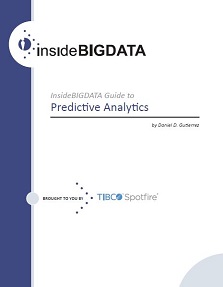In this new Guide to Predictive Analytics we will review how predictive analytics helps your organization predict with confidence what will happen next so that you can make smarter decisions and improve business outcomes. It is important to adopt a predictive analytics solution that meets the specific needs of different users and skill sets from beginners, to experienced analysts, to data scientists.
With predictive analytics software you can:
- Transform data into predictive insights to guide front-line decisions and interactions.
- Predict what customers want and will do next to increase profitability and retention.
- Maximize the productivity of your people and processes.
- Increase the value of your data assets.
- Detect and avoid security threats and fraud before they affect your organization.
- Perform statistical analysis including regression analysis, classification, and cluster analysis.
- Measure the social media impact of your products, services and marketing campaigns.
This article is the first in a series that explores the benefits the business community can achieve by adopting proven predictive analytics technologies. The complete insideBIGDATA Guide to Predictive Analytics is available for download from the insideBIGDATA White Paper Library.
 Predictive Analytics Defined
Predictive Analytics Defined
Predictive analytics, sometimes called advanced analytics, is a term used to describe a range of analytical and statistical techniques to predict future actions or behaviors. In business, predictive analytics are used to make proactive decisions and determine actions, by using statistical models to discover patterns in historical and transactional data to uncover likely risks and opportunities.
Predictive analytics incorporates a range of activities which we will explore in this paper, including data access, exploratory data analysis and visualization, developing assumptions and data models, applying predictive models, then estimating and/or predicting future outcomes.
The History of Predictive Analytics
Modern day predictive analytics has its origin in the 1940s, when governments started using the first computational models — Monte Carlo simulations, computational models for neural networks, and linear programing — for decoding German messages in WWII, automating targeting of antiaircraft weapons against enemy planes, and computer simulations to predict behavior of nuclear chain reactions for the Manhattan Project. In the 1960s, corporations and research institutions began the era of commercializing analytics with nonlinear programming, and computer-based heuristic problem solving — for the first models to forecast the weather, solving the “shortest path problem” to improve air travel and logistics, and applying predictive modeling to credit risk decisions. Then in the 1970s – 1990s analytics was used more broadly in organizations, and tech start-ups made real time and prescriptive analytics a reality. However, predictive analytics mainly remained in the hands of corporate statisticians, brought to the business only in static, batch-driven reports.
Today predictive analytics has finally arrived into the corporate mainstream, being used by everyday business users for a broadening set of use cases. This growing phenomenon has been driven by the realities of a global economy, i.e., organizations continually looking for competitive advantage, and enabled by strong technological innovations.
These technological innovations include more scalable computing power, relational databases, new Big Data technologies, such as Hadoop, and
self-service analytics software that puts data, and predictive models in the hands of front-line decision makers. All of this has allowed organizations to compete based on analytic innovation.
First, organizations embraced simple data discovery analytics to understand the state of their business, and to look deeply in the data to understand the “whys” behind the data. But as they become more comfortable with the data, they see the opportunity to further outperform their competitors using advanced analytics.
Over the next few weeks we will explore these Predictive Analytics topics:
- Business Uses of Predictive Analytics
- Classes of Predictive Analytics
- Predictive Analytics Software Including R
- Data Access and Exploratory Data Analysis
- Predictive Modeling and Production Deployment
If you prefer the complete insideBIGDATA Guide to Predictive Analytics is available for download in PDF from the insideBIGDATA White Paper Library, courtesy of TIBCO Software.




“Predictive Analytics” should not be equated with “Advanced Analytics”. The latter term encompasses descriptive, predictive, and prescriptive analytics, and all of their sub-varieties, used in a synergistic combination to support achievement of non-trivial mission outcomes.